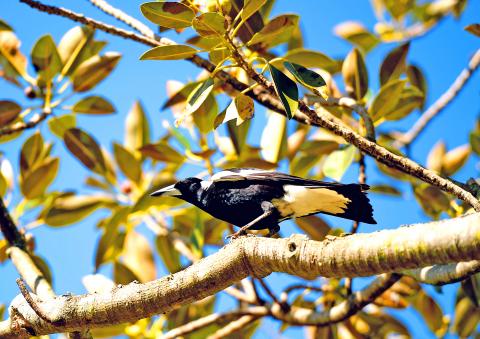Every year in spring, Australians are seen wearing bicycle helmets with spikes on top or caps that have images of eyes on their back. The colorful head gear is not a fashion statement.
Instead, it protects wearers from the swooping magpie, a quintessentially Australian experience where the bird flies low, clacking its beak and sometimes drawing blood by pecking the head of a human victim.
While Australian native animals such as the box jellyfish, funnel web spider and several snake species continue to top the world’s most deadly creature lists, the magpie also regularly hits the headlines.

Photo: AFP/Peter Parks
Claire Dunne was cycling in the Hunter Valley north of Sydney in July when she was attacked and chased by a magpie along a road for half a minute.
“Out of nowhere, a bird — I didn’t know what it was at the time — was pecking at my helmet,” Dunne told AFP. “It swooped again and again, maybe about four or five times in succession. Because of my helmet, I was fine, and I think because of the position I was in, I couldn’t see how big it was, I could just see its shadow.”
“I just thought it was ridiculous... I was like, ‘I can’t believe that just happened.’”
Authorities issue warnings every year on how to deal with the magpie season. The southern state of Victoria even offers a “Swoop Off” kit that includes a set of “eyes” that can be printed out and a warning sign that people can display at attack spots.
But while a close encounter with the magpie’s black-and-white feathers may evoke memories of Alfred Hitchcock’s 1963 film The Birds, experts say its behavior is misunderstood and people’s reactions to its aggression only adds fuel to the fire.
“They’re protecting their nest,” Robert Johnson of the Australian Veterinary Association said of the birds. “It’s the nesting season in spring, but soon those baby birds will be leaving the nest. And once they’ve left the nest and can fly away the swooping season finishes.”
The months of September and October are the typical nesting — and swooping — season, although magpies can breed across a longer period of time according to the climate in the local region.
The magpie, a medium-sized native bird, measures about 40cm long and is believed to live for up to 30 years.
It is commonly found in urban areas across Australia and tends to nest in tall trees such as eucalyptus and gum, and sometimes in open spaces including parks and playing fields.
NO TRESSPASSING
Magpies are territorial and when their nests bring them in close proximity to humans, particularly in public places, there is a greater chance of conflict.
“In public places, they may even feel betrayed because suddenly very strange people enter their territory whom they’ve not seen at the time of nest building and that is equivalent to trespassing,” one of Australia’s leading magpie and animal behavior experts, Gisela Kaplan, told AFP.
Males may first fly a non-contact warning swoop at human intruders, and if they heed the signal and keep a wide berth from the nest, a second flight towards them is unlikely, she said.
“What people actually often do, however, is to respond by waving their arms around or even waving a stick — a signal that is likely to be regarded by the magpie male as a declaration of war,” Kaplan said.
“In other words, the bird sees such human action as an even greater risk and it must now defend its nest more strenuously.”
The birds’ attempts to protect their fledglings has sometimes led to injuries and accidents. In 2010, a 12-year-old boy died after running from a swooping magpie on to a road in Queensland, when he was hit by a car.
More recently, the New South Wales ambulance service said a 12-year-old boy suffered bad cuts to his head after a magpie swooped at him.
The magpiealert.com Web site, which collects reports of attacks, has recorded more than 1,000 swooping incidents across Australia this year, although only 11 percent resulted in injuries. Most of those who reported attacks were cyclists.
Kaplan said magpies — which have relatively long memories and can attack the same people — are falsely vilified, describing them as highly intelligent and peace-loving. The small minority that attack humans often do so because they recall bad experiences from years past, she added.
In contrast, the magpies’ guarding abilities are seen as key among Australian fauna. The bird is sometimes described as the “policeman of the bush,” with its loud call serving as a warning signal to other creatures if danger arises.
Its singing skills and complex calls, as well as a pitch that varies up to four octaves, has seen it regarded as one of the best songbirds in Australia.
“We’ve just got to learn to, as we say in Australia — ‘cop it sweet’ — and just learn to live with these animals,” Johnson said.
“They are just doing what comes naturally. We would want to protect our own children too and they’re just protecting their young.”

Before the recall election drowned out other news, CNN last month became the latest in a long line of media organs to report on abuses of migrant workers in Taiwan’s fishing fleet. After a brief flare of interest, the news media moved on. The migrant worker issues, however, did not. CNN’s stinging title, “Taiwan is held up as a bastion of liberal values. But migrant workers report abuse, injury and death in its fishing industry,” was widely quoted, including by the Fisheries Agency in its response. It obviously hurt. The Fisheries Agency was not slow to convey a classic government

Not long into Mistress Dispeller, a quietly jaw-dropping new documentary from director Elizabeth Lo, the film’s eponymous character lays out her thesis for ridding marriages of troublesome extra lovers. “When someone becomes a mistress,” she says, “it’s because they feel they don’t deserve complete love. She’s the one who needs our help the most.” Wang Zhenxi, a mistress dispeller based in north-central China’s Henan province, is one of a growing number of self-styled professionals who earn a living by intervening in people’s marriages — to “dispel” them of intruders. “I was looking for a love story set in China,” says Lo,

It was on his honeymoon in Kuala Lumpur, looking out of his hotel window at the silvery points of the world’s tallest twin skyscrapers, that Frank decided it was time to become taller. He had recently confessed to his new wife how much his height had bothered him since he was a teenager. As a man dedicated to self-improvement, Frank wanted to take action. He picked up the phone, called a clinic in Turkey that specializes in leg lengthening surgery — and made a booking. “I had a lot of second thoughts — at the end of the day, someone’s going

The next few months will be critical in determining the future of the Taiwan People’s Party (TPP). Following party founder Ko Wen-je’s (柯文哲) arrest in September last year, Huang Kuo-chang (黃國昌) effectively became the de facto face of the party and officially became chairman in January. While Ko frequently criticized the ruling Democratic Progressive Party (DPP) and insinuated sinister intentions on the part of the DPP’s New Tide faction, his era was largely defined by the TPP slogan “rational, pragmatic, scientific,” albeit defined largely by his definition of what that meant. The tone and language used by the TPP changed dramatically